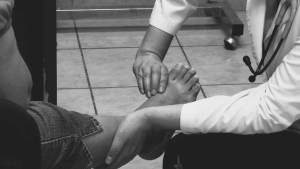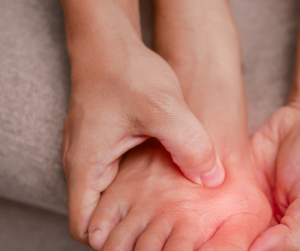If you’ve been dealing with Morton’s neuroma, you know how painful each step can be. That sharp, burning sensation between your toes has probably made walking, running, or even standing difficult.
At The London Foot and Ankle Centre, we want you to know there’s now a modern option that avoids the long recovery often associated with surgery. Radiofrequency treatment is minimally invasive, has a much shorter healing period, and allows most patients to return to their normal lives far more quickly.
What is Morton’s Neuroma?
Morton’s neuroma occurs when the nerves supplying sensation to the toes become compressed and irritated over time. This leads to scarring of the nerve and, in turn, persistent pain in the forefoot. Symptoms often include burning discomfort and numbness in the affected toes.
Pain typically develops in the ball of the foot and radiates toward the toes, most commonly between the third and fourth toes.
If symptoms are left untreated, patients may eventually require Morton’s neuroma treatment to relieve pain and prevent further deterioration.
What is Radiofrequency Treatment?
Radiofrequency treatment is a minimally invasive procedure that uses electrical energy to generate heat and disrupt nerve function. It is widely used to treat chronic pain conditions, including Morton’s neuroma.
By targeting the affected nerve with controlled radiofrequency energy, the procedure reduces or eliminates pain by impairing the nerve’s ability to transmit pain signals to the brain.
The treatment involves the use of a specialised needle, guided precisely to the affected nerve under imaging, where radiofrequency waves are applied to safely heat and modify the nerve tissue.
What to Expect After Treatment
Unlike surgery, recovery after radiofrequency treatment is usually measured in days rather than months.
Here’s a general idea of how the process after radiofrequency treatment unfolds:
- Your main focus is rest and keeping pressure off your foot. The treatment uses radio waves to target and reduce the nerve pain. Due to the minimally invasive nature of this treatment, there is no surgical wound to heal. You may have some soreness or mild swelling, but most patients find this very manageable.
- Walking generally feels much easier after a few days. By this point, many patients are already in regular shoes and moving around with little or no discomfort. Everyday activities often become possible much sooner after this treatment than with surgery.
- Most people feel a significant improvement in symptoms at this stage. Any residual soreness usually continues to fade, and you should be able to resume most normal activities without restriction.
Managing Pain and Swelling
Because radiofrequency treatment doesn’t involve removing tissue, pain and swelling are usually minimal. Basic home care, such as rest and occasional icing, is often sufficient. Elevating your foot after treatment can still help speed recovery and keep swelling under control.
You may notice some odd sensations in your foot as the nerve settles down. This is a normal part of healing and usually improves over the following weeks.
How to Recognise Complications
Complications after radiofrequency treatment are uncommon. Mild soreness, swelling, or temporary changes in sensation are considered normal.
However, if you experience pain that worsens rather than improves, or any signs of infection such as redness or discharge at the treatment site, you should contact your consultant promptly.
Long-Term Solutions
At The London Foot and Ankle Centre, we have the most extensive experience of radiofrequency treatment in the UK, and results are consistently excellent. Most patients achieve long-term pain relief without the need for surgery.
In the small number of cases where radiofrequency treatment does not provide sufficient relief, surgery can still be performed later without additional risk of complications. This makes radiofrequency treatment both an effective first choice and a safe one.
Maintaining good footwear habits, a healthy weight, and addressing any underlying biomechanical issues are still important in preventing symptoms from returning. Supportive shoes with wide toe boxes and cushioning remain the best long-term investment for foot health.
Your consultant will monitor your recovery, address any concerns, and provide guidance for returning to all your desired activities safely. Schedule regular follow-up appointments to ensure your recovery progresses smoothly and safely.


Matthew Solan
This article was reviewed by Mr Matthew Solan, a consultant orthopaedic surgeon. He has been with LFAC since its formation in 2003.


